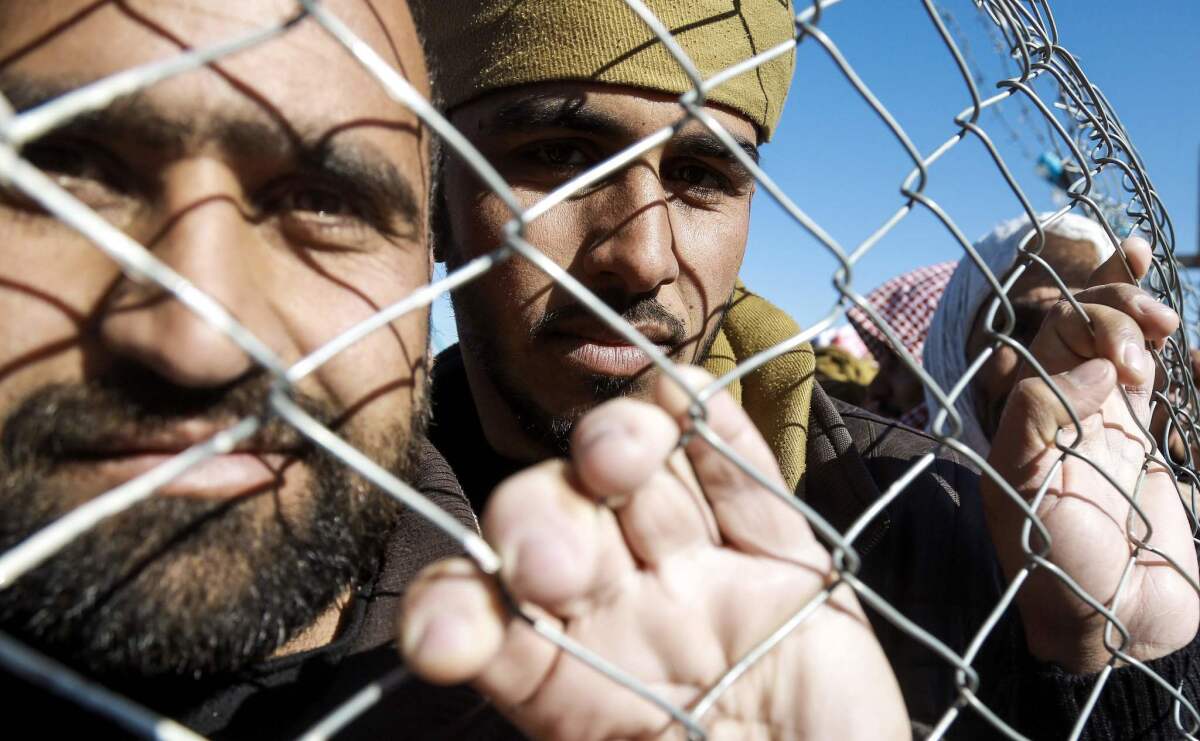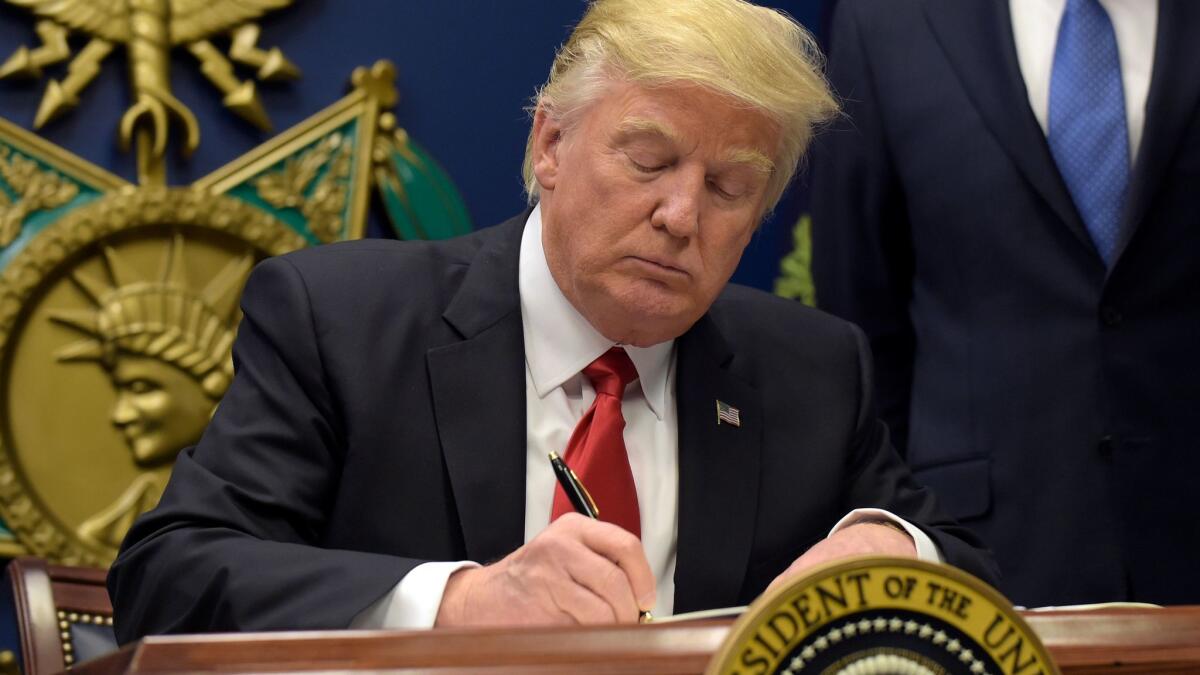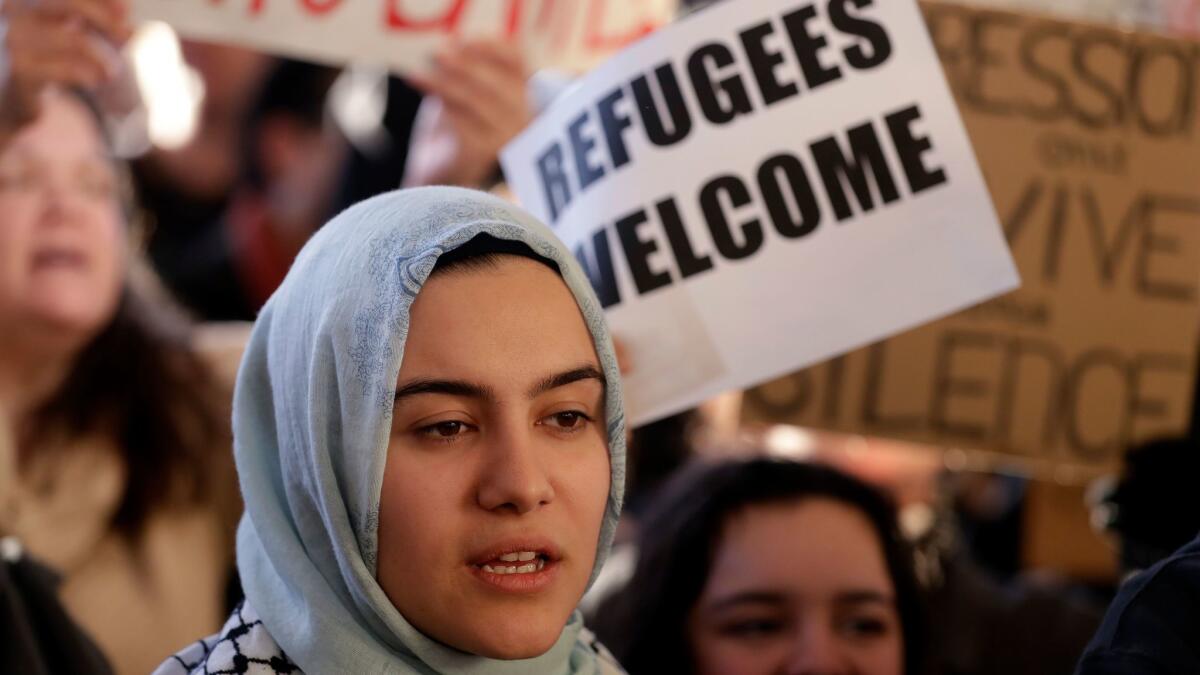We don’t know exactly what ‘extreme vetting’ will look like, but screening for refugees is already pretty tough

- Share via
The Trump administration’s temporary ban on refugees entering the United States until measures can be adopted to ensure more “extreme vetting” has sparked criticism from human rights activists, security specialists and some U.S. lawmakers. They argue that current screening procedures for refugees are already adequately exhaustive and rigorous.
“I just struggle to see how it can be made much more thorough than it already is,” said John Sandweg, former acting general counsel to the Department of Homeland Security and former acting director of Immigration and Customs Enforcement. “It’s an intentionally slow process. It’s a multilayered and multilevel approach.”
Homeland Security is among the entities heavily involved in the screening, together with multiple intelligence agencies, the Department of Defense and other law enforcement agencies.
“Refugees are more scrutinized than other traveler to the U.S., ”said Noah Gottschalk, a Washington-based senior humanitarian policy advisor for Oxfam America.
But critics say no system is fail-safe and they insist loopholes exist — such as the lack of proper documents by people fleeing war — that could allow those who want to harm Americans to slip in as refugees.

Here’s how the system works
The refugee intake program begins with the United Nations Commissioner for Refugees, which registers individuals claiming to be refugees. The agency determines, usually through an interview, whether an applicant qualifies under international laws for refugee status and collects identity documents, biographical information, and biometric data, such as iris scans for Syrians, according to information published by the U.S. Committee for Refugees and Immigrants, or USCRI. An initial rough cut of refugees is then referred to the U.S. government for resettlement.
Refugee support centers, contracted by the U.S. State Department, compile a refugee’s personal data and background information for the security clearance process and an in-person interview with U.S. Citizenship and Immigration Services. According to USCRI, the State Department checks the refugee’s name against a “watch list.” Certain refugees might be required to undergo an additional security review, according to the agency’s checklist.
The National Counterterrorism Center then conducts an inter-agency check on certain applicants, such as males considered to be of combat age and those who are single with no family commitments or ties, to determine if any new “derogatory information” has come up since the initial check that might disqualify the applicant, according to the U.S. refugee agency.
“There are individuals who are collecting information on the battlefield, from sources and electronic intercepts. That is all fed into the refugee screening process.” said Sandweg, who as acting director of ICE led around 20,000 employees across the U.S. and in 47 countries.
Syrian refugees referred for resettlement in the U.S. face additional screening. Before Citizenship and Immigration Services schedules an interview with the applicant abroad, officials with the agency review the application and investigate any discrepancies.
Once an applicant is cleared to move forward, Citizenship and Immigration Services officers conduct another in-person interview that includes any family member older than 14.
The officers are highly trained, Sandweg said. “Not only is the applicant’s eligibility checked, they are looking for inconsistencies,” he said.
The officers collect the applicant’s fingerprints and photographs and determine whether the individual qualifies as a refugee. Only then is the status conditionally approved for resettlement and submitted to the U.S. State Department for final processing.
What happens next?
The applicant’s fingerprints are screened by the FBI, the U.S. Department of Homeland Security and the Department of Defense before the candidate for resettlement is sent for medical tests to ensure that he or she is free of any communicable diseases “that could pose a public health threat,” according to USCRI.
Once the results of the security checks and medical screening have been cleared, the refugee is approved for resettlement.
The entire screening process takes between 18 months and two years, according to U.S. State Department data.
But the vetting doesn’t end there. The refugee faces further interrogation at the border upon entry to the U.S.

“The individuals are recurrently vetted even after they are in the United States,” Sandweg said. “You are constantly running them through a database to see if any new information has come in to say that they are a threat.”
The State Department also requires that the resettlement agencies provide employment statistics after refugees have been in the country for three months, according to the department’s Bureau of Population, Refugees and Migration.
Why do critics insist the vetting isn’t stringent enough?
Critics say records can be questionable when dealing with people who are fleeing conflict and may not have proper documents, allowing would-be terrorists to slip in.
In the aftermath of the series of coordinated attacks in Paris in November 2015 in which Islamic State militants killed 120 people, authorities revealed that two of the attackers entered Europe by posing as refugees and using fake Syrian passports.
As a result, at least 31 U.S. governors vowed not to take in any more Syrian refugees.
Security experts acknowledged that no system is completely foolproof but insisted that the situation in the U.S. differs from Europe, where migrants were streaming across the border.
“Refugees were getting into Europe without any vetting whatsoever,” Sandweg said. “It’s a radically different situation in the U.S.”
How will extreme vetting affect those already in the pipeline?
Tens of thousand of refugees are currently in the process of being vetted, and completed security checks and medical screenings are valid for only a limited time, humanitarian officials say.
If these approved checks expire, “you will be resetting the clock,” Gottschalk said. “You will be asking many refugees to start from square one. Even a suspension of one month could be enough to make these refugees start from the beginning.”
The Obama administration had wanted to increase the refugee intake from 85,000 to 110,000 in fiscal year 2017. Trump’s executive order limits the total number of refugees allowed into the U.S. to 50,000 this year.
ALSO
When Muslims got blocked at American airports, U.S. veterans rushed to help
The uncensored Trump repeatedly interrupted the more sober one in the first week
More to Read
Sign up for Essential California
The most important California stories and recommendations in your inbox every morning.
You may occasionally receive promotional content from the Los Angeles Times.











